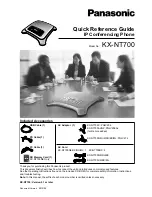
Service Manual
6-253
Configuring the system specifically for the client
Comments about the system’s programming codes
Call Forwarding - Busy after Call Forwarding No Answer (185)
When this feature is activated, an extension configured for Call Forwarding - No Answer (see Call Forwarding - No Answer, in
the User Manual) routes incoming calls to the same destination configured for Call Forwarding - Busy.
.
Permission for conditional call forwarding (247)
This allows an extension to forward a call to an external line.
6.3.3.1
External Message Waiting Indicator (MWI)
With this feature a group of extensions called an external MWI Group is able to receive signals generated by the Voice Mail
Server that indicate when there is a message waiting in the user’s mailbox.
Activating external Message Waiting Indicator (014)
Activates the MWI feature for a group of extensions.
External MWI Group (015)
Extensions configured in this group are allowed to receive a Message Waiting Indicator from an external Voice Mail Server
where user’s messages and greetings are stored.
Message Waiting server number (065)
This setting specifies an MSN number for the Waiting Message server.
6.3.4
DISA
This setting allows you to make an external call from an external telephone (as if it was an extension) through your system. In
addition, the following features can be activated or deactivated: Call Forwarding, Feature Deactivation, Conference, Night ser-
vice, Suffix-Dialing, Door Opener, Electronic Lock, Individual Speed Dial, System Speed Dial, Relay, and Do Not Disturb.
Urgent Call and Callback when Busy facilities do not work when Call Forwarding - Busy and Call Forwarding - No
Answer are activated.
If the extension called is configured to use Do Not Disturb and Call Forwarding - Busy then the call will be for-
warded. If Do Not Disturb is enabled at the destination to which the call is forwarded, the caller will hear a busy
signal.
For standard telephones with a display, MWI will only be indicated if a CLIP is con-
figured for the extension using option 3 or 4 ( “Call Identification for analog extension
(CLIP)” on page 6-213).
Only one external call can be made or one feature can be used at a time. After suc-
cessful activation of a feature, the call is immediately terminated. In the case of a
call, it is terminated right after a caller hangs up.
TAPI only monitors physical ports. To operate correctly, a DISA feature must use special ports, and those cannot
be monitored. If a physical port is used when the DISA feature is active, the TAPI will be able to monitor it.
Содержание HiPath 1100
Страница 1: ...HiPath 1100 HiPath 1120 HiPath 1150 HiPath 1190 Service Manual ...
Страница 14: ...Figures 14 Service Manual ...
Страница 124: ...Modules 3 124 Service Manual Interconnect cables ...
Страница 162: ...Installation 4 162 Service Manual Installing modules Figure 4 31 Installing a Music module HiPath 1120 ...
Страница 190: ...Installation 4 190 Service Manual Performing a visual inspection ...
Страница 323: ...Service Manual 7 323 Operation Driver Installation Figure 7 44 Windows 2000 Driver location ...
Страница 368: ...Operation 7 368 Service Manual HiPath 1100 applications ...
Страница 384: ...Abbreviations 9 384 Service Manual ...
Страница 388: ...388 Service Manual ...
















































